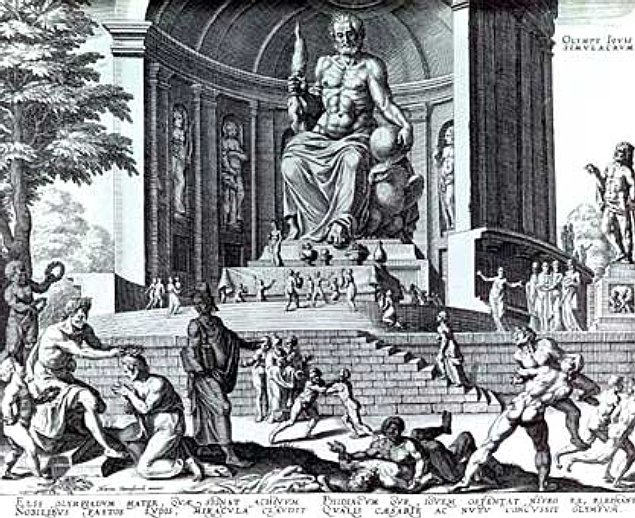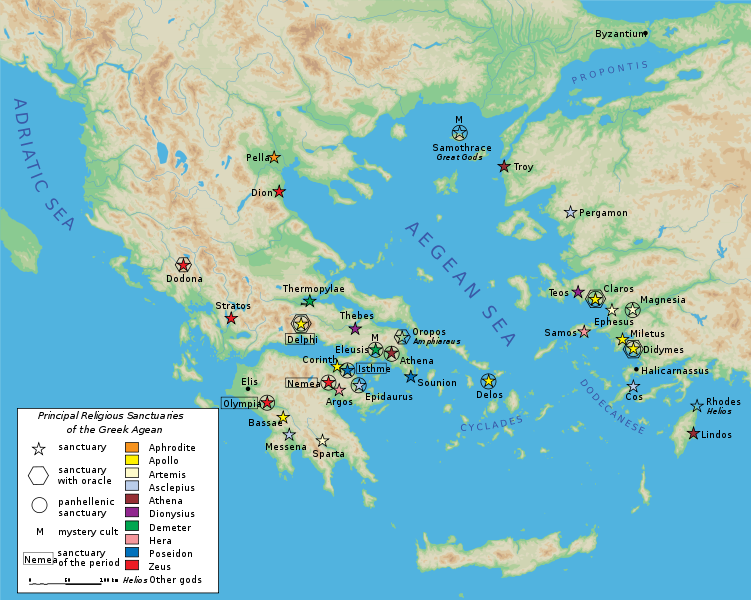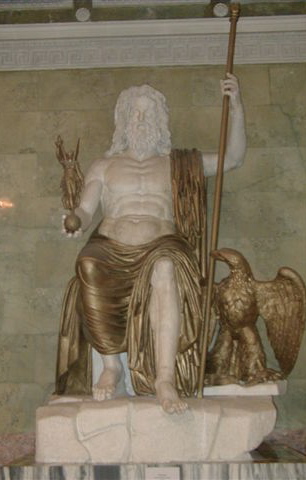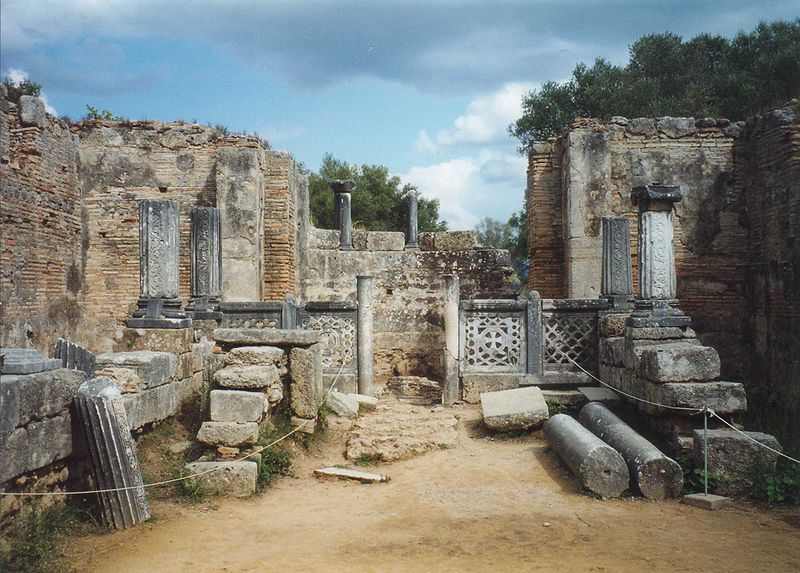<Back to Index>
- Olympia, Greece Statue of Zeus, 432 B.C.
PAGE SPONSOR


The Statue of Zeus at Olympia was made by the Greek sculptor Phidias, circa 432 BC on the site where it was erected in the Temple of Zeus, Olympia, Greece. It was one of the Seven Wonders of the Ancient World.
The seated statue, some 12 meters (43 feet) tall, occupied half of the width of the aisle of the temple built to house it. "It seems that if Zeus were to stand up," the geographer Strabo noted early in the 1st century BC, "he would unroof the temple." The Zeus was a chryselephantine sculpture, made of ivory and gold plated bronze. No copy in marble or bronze has survived, though there are recognizable but approximate versions on coins of nearby Elis and on Roman coins and engraved gems. A very detailed description of the sculpture and its throne was recorded by the traveler Pausanias, in the 2nd century AD. The sculpture was wreathed with shoots of olive worked in gold and seated on a magnificent throne of cedarwood, inlaid with ivory, gold, ebony, and precious stones. In Zeus' right hand there was a small statue of crowned Nike, goddess of victory, also chryselephantine, and in his left hand, a sceptre inlaid with gold, on which an eagle perched. Plutarch, in his Life of the Roman general Aemilius Paulus, records that the victor over Macedon, when he beheld the statue, “was moved to his soul, as if he had seen the god in person,” while the 1st century AD Greek orator Dio Chrysostom declared that a single glimpse of the statue would make a man forget all his earthly troubles.
The date of the statue, in the third quarter of the 5th century BC, long a subject of debate, was confirmed archaeologically by the rediscovery and excavation of Phidias' workshop.
According to a legend, when Phidias was asked what inspired him — whether he climbed Mount Olympus to
see Zeus, or whether Zeus came down from Olympus so that Pheidias could
see him — the artist answered that he portrayed Zeus according to Book
One, verses 528 – 530 of Homer's Iliad:
- ἦ καὶ κυανέῃσιν ἐπ' ὀφρύσι νεῦσε Κρονίων
- ἀμβρόσιαι δ' ἄρα χαῖται ἐπερρώσαντο ἄνακτος
- κρατὸς ἀπ' ἀθανάτοιο μέγαν δ' ἐλέλιξεν Ὄλυμπον.
- He spoke, the son of Kronos, and nodded his head with the dark brows,
- and the immortally anointed hair of the great god
- swept from his divine head, and all Olympos was shaken.
The sculptor also was reputed to have immortalized his eromenos, Pantarkes, by carving "Pantarkes kalos" into the god's little finger, and placing a relief of the boy crowning himself at the feet of the statue.
According to Suetonius, the Roman Emperor Caligula "gave orders that such statues of the gods as were especially famous for their sanctity or for their artistic merit, including that of Zeus at Olympia, should be brought from Greece, in order to remove their heads and put his own in their place." Caligula was assassinated in AD 41. In Rome other interpretations were placed on the phenomenon: according to Suetonius, Caligula's "approaching murder was foretold by many prodigies. The statue of Jupiter at Olympia, which he had ordered to be taken to pieces and moved to Rome, suddenly uttered such a peal of laughter that the scaffolding collapsed and the workmen took to their heels."
The circumstances of its eventual destruction are a source of debate: the 11th century Byzantine historian Georgios Kedrenos recorded the tradition that it was carried off to Constantinople, where it was destroyed in the great fire of the Lauseion, in AD 475. Others argue that it perished with the temple when it burned in 425. According to Lucian of Samosata in the later 2nd century, "they have laid hands on your person at Olympia, my lord High - Thunderer, and you had not the energy to wake the dogs or call in the neighbors; surely they might have come to the rescue and caught the fellows before they had finished packing up the swag."
Perhaps
the greatest discovery came in 1954 – 1958 with the excavation of the
workshop at Olympia where Phidias created the statue. Tools, terracotta moulds and a cup inscribed "I belong to Pheidias" were found here, just where the traveler Pausanias said the Zeus was constructed. This has enabled archaeologists to re-create the techniques used to make the great work and confirm its date.

